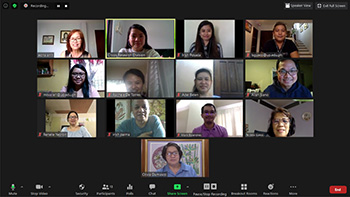 A less-studied but major constraint on banana production called “banana bract mosaic disease (BBrMD)” will now be explored through a three-year program funded by the Philippine Council for Agriculture, Aquatic and Natural Resources Research and Development of the Department of Science and Technology (DOST-PCAARRD).
A less-studied but major constraint on banana production called “banana bract mosaic disease (BBrMD)” will now be explored through a three-year program funded by the Philippine Council for Agriculture, Aquatic and Natural Resources Research and Development of the Department of Science and Technology (DOST-PCAARRD).
The program, “Banana Bract Mosaic Disease in the Philippines: Geographic Distribution, Yield Loss Assessment, Virus Elimination, and Evaluation of Germplasm Collection,” will be implemented by experts and researchers from the University of the Philippines Los Baños (UPLB).
BBrMD is caused by banana bract mosaic virus (BBrMV) more common in ‘Saba’ and ‘Cardaba’ bananas but can also infect the ‘Cavendish’ in the Philippines.
It causes mosaic patterns, discoloration, streaks on different parts of banana plant – bract, pseudostem, and leaf. Severe infection may lead to failure of flowering and 40–70% yield reduction.
Despite its damaging impact to banana production, there is very limited information on the virus, its extent of infection in the country, and control. To date, no synthetic chemicals and proper management practices are in place to control the disease. There are also minimal BBrMV-free planting materials available to banana farmers.
These gaps are expected to be addressed by the new program.
The program has four component projects, which aim to detect and analyze genetic diversity of BBrMV, assess yield loss and nutrient management, eliminate virus and produce BBrMV-free planting materials, and study the sources and mechanism of resistance to BBrMD.
Incidence and distribution maps of BBrMV in the Philippines and information on genetic relationships of BBrMV isolates, alternative hosts, yield loss data on different banana cultivars, nutrient management regime for BBrMD mitigation, and BBrMV-resistant banana genotypes are some of the target outputs.
Technologies such as protocols on BBrMV detection and elimination, and improved micropropagation of BBrMV-free Saba are also expected to be developed.
Moreover, BBrMV detection procedures that will be optimized by the program team can be used by banana tissue culture laboratories in detecting BBrMV in asymptomatic plants. This is to ensure that planting materials to be planted or disseminated are disease-free. Ultimately, these new knowledge and technologies will assist plant breeders in developing BBrMD-resistant varieties.
The online inception meeting served as a platform to launch the program. It was attended by 13 participants from UPLB and Crops Research Division (CRD) of DOST-PCAARRD. R&D activities will officially commence on September 1, 2020 under the leadership of Dr. Fe M. Dela Cueva of the Institute of Plant Breeding, UPLB.
DOST-PCAARRD’s Banana Industry Strategic S&T Program (ISP) has been addressing R&D gaps on devastating banana diseases such as Fusarium wilt and banana bunchy top disease through generation of information and technologies on disease management. With the threat of BBrMD infection, the conduct of R&D activities to study and manage the disease is being prioritized to prevent its widespread occurrence in the country.
